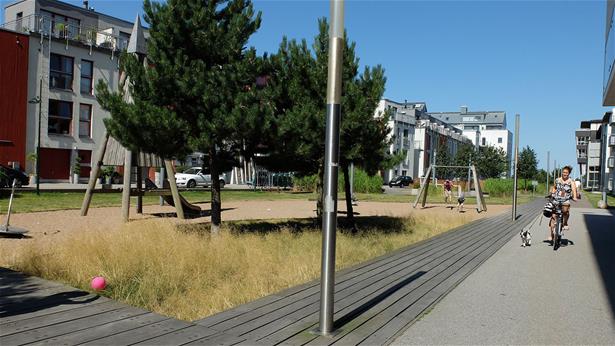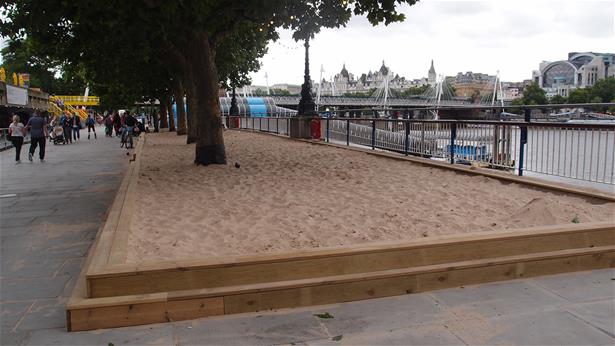A LANDSCAPE FOR PLAY
Contents
- 0.1 When a designer is assigned to plan a playground, what do they consider first? Quite honestly: the money and the space available. In the worst case, the design process little else than fitting the playground equipment in place and calculating the costs. But is this good enough? No, nowhere near, but sadly this is how playground designers often tend to work.
- 0.2 “Safety is key, but it cannot be the only factor when designing playgrounds”
- 1 Original text and photos: Eeva Blomberg
When a designer is assigned to plan a playground, what do they consider first? Quite honestly: the money and the space available. In the worst case, the design process little else than fitting the playground equipment in place and calculating the costs. But is this good enough? No, nowhere near, but sadly this is how playground designers often tend to work.
When the yard of a residential building is being renovated, you often hear from the residents that nowadays only a few children living in the building. It is sometimes even suggested that the playground be replaced by a car park, although before making changes of that scale, the town plan should always be checked. A leafy, well-tended playground may be an asset when selling your flat, while an untidy yard with worn-out equipment may put off potential buyers. A good idea would be for neighbouring housing companies to join forces and build a shared playground rather than several smaller separate play areas for each housing company.
In any case, there is no escaping the spatial and budgetary limitations. Where there is little space, much of which must also be accessible to rescue and service vehicles, an ideal solution might be a hard-surfacing material that would be suitable for children’s outdoor games while being durable and wide enough for heavy fire engines. Winter maintenance creates other problems. Garden furniture can be easily removed to clear the way for snow ploughs, but playground equipment is firmly fixed to the ground.

Small playground in Malmö, Sweden, blends into the surroundings emphasizing the marine atmosphere of the area.

A large sandbox by Themes river.
Children love nature and the adventures it offers. If a playground can be situated near a rock, a body of water or next to a forest, this will open up a whole world of possibilities. Even a single large tree may connect a playground to the surroundings, provide shelter and shade and make the location special. Children love old fallen trees and a varied terrain offering hiding places, let alone water games. Adults may not always agree, as they have the wet shoes and muddy clothes to deal with afterwards, and children could hurt themselves falling down from a tree trunk. Hiding places are not ideal at a kindergarten playground as it makes supervising the children difficult. Building dens is forbidden in public areas, because if something did happen, nobody would want to take the responsibility. The downside of this is that children are not provided enough opportunities to modify and change their environment, with the result that the possibilities afforded by an environment are far too quickly exhausted and it becomes boring.
Children are natural explorers. Toddlers love feeling different surfaces and textures, and overcoming the challenge posed by a simple kerbstone, and all the potholes, dents and stairs along the way must be carefully investigated. A two-year-old cannot yet play with others, but a five-year-old will make friends with anyone. When designing a playground, it is important to take into consideration how many children will be using it and what their ages will be: a schoolyard for kids in their early teens can’t be designed for small children. Children in general are getting less exercise these days than previously, and schoolyards play an important role in encouraging children to be active. We also know that physical activity during break times improves children’s ability to concentrate and learn.
“Safety is key, but it cannot be the only factor when designing playgrounds”
There is a town in Finland where planting berry bushes in kindergarten yards is prohibited, for reasons of health and safety. The belief is that, if children learn to eat berries straight from the bush at day care, they may think that all berries are safe to eat and may die from poisoning. Are these people serious? Playgrounds with steel fences separating different functions for ease of maintenance and supervision, as they cannot be climbed on, are in my opinion simply oppressive. Is there really no other way except a steel fence to separate the swings from other activities? How about placing the swings on a raised level, or building a balance beam as a space divider – and yes, with the purpose that it is walked and balanced on, naturally taking into account the necessary safety distance. Climbing and balancing is good for kids.
The best playground is one that effortlessly incorporates itself into the surrounding landscape and plants and that is naturally attractive to children. Since small children in a playground need to be accompanied by an adult, the playground must be attractive for adults as well. If the designer succeeds in evoking and making use of the natural spirit of the place and sees that children enjoy the opportunities offered by the site, she can congratulate herself for a job well done.
Original text and photos: Eeva Blomberg
Eeva Blomberg is a landscape designer, contract administrator and the president of Maisemasuunnittelijat ry, a Finnish association for landscape designers. She is also in the board and in the education team of The Finnish Association of Landscape Industries, Viherympäristöliitto ry VYL, and writes columns to a Finnish landscape industry magazine called Viherympäristö. Eeva is a designer horticulturist and a garden teacher. Her company Pihasuunnittelu Eeva Blomberg was established in 1998.

